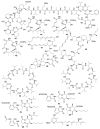From Ocean to Medicine: Pharmaceutical Applications of Metabolites from Marine Bacteria
- PMID: 32731464
- PMCID: PMC7460513
- DOI: 10.3390/antibiotics9080455
From Ocean to Medicine: Pharmaceutical Applications of Metabolites from Marine Bacteria
Abstract
Oceans cover seventy percent of the planet's surface and besides being an immense reservoir of biological life, they serve as vital sources for human sustenance, tourism, transport and commerce. Yet, it is estimated by the National Oceanic and Atmospheric Administration (NOAA) that eighty percent of the oceans remain unexplored. The untapped biological resources present in oceans may be fundamental in solving several of the world's public health crises of the 21st century, which span from the rise of antibiotic resistance in bacteria, pathogenic fungi and parasites, to the rise of cancer incidence and viral infection outbreaks. In this review, health risks as well as how marine bacterial derived natural products may be tools to fight them will be discussed. Moreover, an overview will be made of the research pipeline of novel molecules, from identification of bioactive bacterial crude extracts to the isolation and chemical characterization of the molecules within the framework of the One Health approach. This review highlights information that has been published since 2014, showing the current relevance of marine bacteria for the discovery of novel natural products.
Keywords: One Health; anticancer; antimicrobial resistance; antimicrobials; antivirals; bioactive marine bacteria; cancer incidence; drug discovery; marine natural products.
Conflict of interest statement
J.D.S., I.V. and O.M. declare no conflict of interest. F.R. and F.V. disclosed the receipt of financial support from Fundación MEDINA, a public–private partnership of Merck Sharp & Dohme de España S.A./Universidad de Granada/Junta de Andalucía.
Figures







References
-
- WHO . Global Antimicrobial Resistance Surveillance System (GLASS) Report: Early Implementation 2017–2018. World Health Organization; Geneva, Switzerland: 2019.
-
- WHO . Antimicrobial Resistance: Global Report on Surveillance. World Health Organization; Geneva, Switzerland: 2014. p. xxii.232p
-
- WHO . Global Priority List of Antibiotic-Resistant Bacteria to Guide Research, Discovery, and Development of New Antibiotics. World Health Organization; Geneva, Switzerland: 2017. p. 7.
Publication types
Grants and funding
LinkOut - more resources
Full Text Sources

